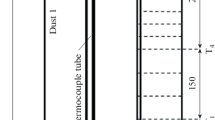Abstract
A new process is described for purifying metals by fractional solidification. The process comprises isothermal compression of solute-rich interdendritic liquid from semi-solid starting material. Purification is measured by “refining ratio”, ¯Cc/Co (where ¯Cc is wt pct solute of the refined “cake” and Co is initial pct solute). Refining ratio depends on partition ratio,K, initial fraction solid, amount of liquid retained in the “cake”, and extent of diffusion in the solid. For intermediate fractions solid and low retained liquid, ¯Cc/Co ≈ k. Refining experiments were conducted on Sn-Pb alloys. Semi-solid samples were isothermally compressed against a filter under controlled strain to pressures up to 21 MPa (2900 psi). The pct solute of the liquid squeezed from the sample was that given by the liquidus curve of the phase diagram. The amount of liquid removed depended on fraction liquid initially present and applied pressure, and not on plunger speed in the range of 10−3 to 10−1f cmJ.s. At 21 MPa (2900 psi) and fractions solid up to 0.7, over 95 pct of the interdendritic liquid present was removed so that fraction liquid in the final “cake” (“cake wetness”) was reduced to about 0.04. Refining ratios within 80 pct of the theoretical minimum were obtained. Refining ratios obtained ranged from 0.1 at 0.08 to 0.4 at 0.8 fraction solid.
Similar content being viewed by others
References
William G. Pfann:Zone Melting, John Wiley and Sons, Inc., New York, 1958.
A. F. Johnson: U.S. Patent No. 3,239,899, March 15,1966.
A. H. Worth:The Chenus try and Technology of Waxes, 2nd Ed., p. 399, Reinhold, New York, 1956.
F. W. Schwab and E. Wichers:J. Res. Nat. Bur. Stand., 1944, vol. 32,p.253.
M. Straumanis:Z. Anorg. All. Chem., 1929, vol. 180, p. 1; through CA, vol. 23, p. 5376.
J. G. D. Molinari:Ind. Chem., 1961, vol. 37, p. 323.
A. S. Russell, S. C. Jacobs,N. Jarrett, and B. M. Starner:Trans. TMS-A1ME, 1967, vol. 239, p. 1630.
N. Jarrett, B. M. Starner, S. C. Jacobs, and L. L. Knapp: U.S. Patent No. 3,211,547-700, October 12, 1965.
G. C. Robinson and 0. R. Singleton: U. S. Patent No. 3,374,089, March 19, 1968.
Paul Kemp: British Patent No. 508,925, July 7, 1939.
M. C. Flemings, R. Mehrabian, and D. Geiger: U. S. Patent No. 3,840,364, October 8,1974.
M. Zief and W. R. Wilcox:Fractional Solidification. Marcel Dekker, Inc., New York, 1967.
Author information
Authors and Affiliations
Additional information
This paper is based on doctoral thesis work of A. L. Lux.
Rights and permissions
About this article
Cite this article
Lux, A.L., Flemings, M.C. Refining by fractional solidification. Metall Trans B 10, 71–78 (1979). https://doi.org/10.1007/BF02653975
Received:
Issue Date:
DOI: https://doi.org/10.1007/BF02653975




